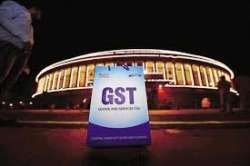2 GST slabs? Niti Aayog member has a suggestion
Government think-tank Niti Aayog member Ramesh Chand on Wednesday made a case for only two slabs under the goods and service tax regime as against the multiple slabs currently, and said rates should be revised annually if required.

Government think-tank Niti Aayog member Ramesh Chand on Wednesday made a case for only two slabs under the goods and service tax regime as against the multiple slabs currently, and said rates should be revised annually if required. The goods and services tax (GST), which replaced almost all the indirect taxes, came into force from July 1, 2017, and the rates on goods and services have been revised several times since then.
Currently, there are four GST rate slabs -- 5 per cent, 12, per cent, 18 per cent and 28 per cent. Several items fall in exempt category or nil duty. Besides, cess is also levied on five goods.
Talking to PTI, Chand said that when a large taxation reforms like GST are brought in, there are always "teething problems" but soon they stabilise. He said most of the countries took long time for GST stabilisation.
The Niti Aayog member, who looks after the agriculture sector, is also strictly against frequent changes in GST rates as it leads to problems. The all-powerful GST Council, presided over by the Union finance minister and comprising state finance ministers, decides on rate for particular goods and services.
Besides frequent demand for reduction in the rates on various goods and services, there has also been clamour for a slash in the number of tax slabs.
"It has become tendency of every sector to ask for lower GST. I feel GST issues are much larger than asking for rates," Chand said. And, "we should not fiddle with rates or change rates frequently... We should not have many rates. Have only two rates," he said.
Chand said the focus should be on steady increase in revenue collection from the new indirect tax regime rather than tinkering with rates. He prescribed that if at all rates need to be changed, it should be done annually.
On demands of lower GST on process food, like dairy products, Chand, an agri economist, said the 5 per cent GST on such products is "very very reasonable".
Chand said that while every sector is demanding lower rate, they should also understand governments need revenue to spend on development works.
"We always ask from the government and forget to give back. This trend is not good. From where will the government get the money to spend for development," said Chand, who is also a member of the 15th Finance Commission.
He said that in the agriculture sector alone, the central government is providing a subsidy of Rs 1.2 lakh crore and the states put together spend about Rs 1 lakh crore.